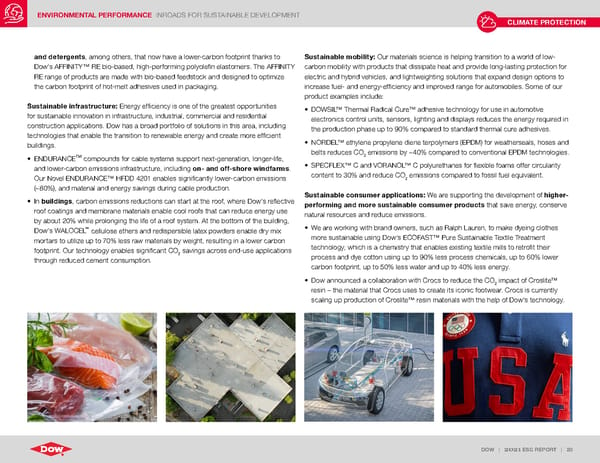ENVIRONMENTAL PERFORMANCE INROADS FOR SUSTAINABLE DEVELOPMENT DOW | 2021 ESG REPORT | 20 and detergents , among others, that now have a lower-carbon footprint thanks to Dow’s AFFINITY™ RE bio-based, high-performing polyolefin elastomers. The AFFINITY RE range of products are made with bio-based feedstock and designed to optimize the carbon footprint of hot-melt adhesives used in packaging. Sustainable infrastructure: Energy efficiency is one of the greatest opportunities for sustainable innovation in infrastructure, industrial, commercial and residential construction applications. Dow has a broad portfolio of solutions in this area, including technologies that enable the transition to renewable energy and create more efficient buildings. • ENDURANCE TM compounds for cable systems support next-generation, longer-life, and lower-carbon emissions infrastructure, including on- and off-shore windfarms . Our Novel ENDURANCE™ HFDD 4201 enables significantly lower-carbon emissions (~80%), and material and energy savings during cable production. • In buildings , carbon emissions reductions can start at the roof, where Dow’s reflective roof coatings and membrane materials enable cool roofs that can reduce energy use by about 20% while prolonging the life of a roof system. At the bottom of the building, Dow’s WALOCEL ™ cellulose ethers and redispersible latex powders enable dry mix mortars to utilize up to 70% less raw materials by weight, resulting in a lower carbon footprint. Our technology enables significant CO 2 savings across end-use applications through reduced cement consumption. Sustainable mobility: Our materials science is helping transition to a world of low- carbon mobility with products that dissipate heat and provide long-lasting protection for electric and hybrid vehicles, and lightweighting solutions that expand design options to increase fuel- and energy-efficiency and improved range for automobiles. Some of our product examples include: • DOWSIL™ Thermal Radical Cure™ adhesive technology for use in automotive electronics control units, sensors, lighting and displays reduces the energy required in the production phase up to 90% compared to standard thermal cure adhesives. • NORDEL™ ethylene propylene diene terpolymers (EPDM) for weatherseals, hoses and belts reduces CO 2 emissions by ~40% compared to conventional EPDM technologies. • SPECFLEX™ C and VORANOL™ C polyurethanes for flexible foams offer circularity content to 30% and reduce CO 2 emissions compared to fossil fuel equivalent. Sustainable consumer applications: We are supporting the development of higher- performing and more sustainable consumer products that save energy, conserve natural resources and reduce emissions. • We are working with brand owners, such as Ralph Lauren, to make dyeing clothes more sustainable using Dow’s ECOFAST™ Pure Sustainable Textile Treatment technology, which is a chemistry that enables existing textile mills to retrofit their process and dye cotton using up to 90% less process chemicals, up to 60% lower carbon footprint, up to 50% less water and up to 40% less energy. • Dow announced a collaboration with Crocs to reduce the CO 2 impact of Croslite™ resin – the material that Crocs uses to create its iconic footwear. Crocs is currently scaling up production of Croslite™ resin materials with the help of Dow’s technology. CLIMATE PROTECTION
 ESG Report | Dow Page 19 Page 21
ESG Report | Dow Page 19 Page 21